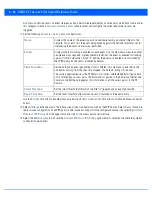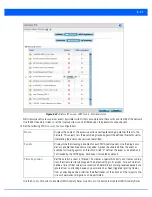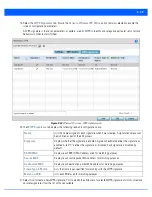
9 - 3
5. Select
Add
to create a new captive portal policy,
Edit
to modify an existing policy or
Delete
to remove an existing captive
portal policy. Select
Copy
to create a copy of an existing captive portal policy and use it for further customization. Use
Rename
to rename an existing captive portal policy.
The
Basic Configuration
tab displays by default. Define the policy’s security, access and whitelist basic configuration
before defining HTML pages for guest user access.
Captive Portal Server
Host
Lists the IP address (or DNS hostname) of the external (centralized) server validating guest
user permissions for the listed captive portal policy.
Captive Portal IPv6
Server
Lists the IPv6 formatted IP address (non DNS hostname) of the external (fixed) IPv6 server
validating user permissions for the listed captive portal policy. This item remains empty if
the captive portal is hosted locally. IPv6 addresses are composed of eight groups of four
hexadecimal digits separated by colons.
Captive Portal Server
Mode
Lists each hosting mode as either
Internal
(Self) or
External
(centralized). If the mode is
Internal (Self), the access point maintains the captive portal internally, while External
(centralized) means the captive portal is running on the adopting wireless controller.
Hosting VLAN Interface
When
Centralized Server
is selected as the
Captive Portal Server Mode
, a VLAN is defined
where the client can reach the controller. 0 is the default value.
Connection Mode
Lists each policy’s connection mode as either
HTTP
or
HTTPS
. It is recommended to use
HTTPS as it offers client transmissions a measure of data protection HTTP cannot provide.
Simultaneous Users
Displays the number of users permitted at one time for each listed policy.
Web Page Source
Displays whether the captive portal HTML pages are maintained
Internally, Externally
(on
an external system you define) or are
Advanced
pages maintained and customized by the
network administrator. Internal is the default setting.
AAA Policy
Lists each AAA policy used to authorize client guest access requests. The security
provisions provide a way to configure advanced AAA policies that can be applied to
captive portal policies supporting authentication. When a captive portal policy is created
or modified, a AAA policy must be defined and applied to authorize, authenticate and
account user requests.
Summary of Contents for WiNG 5.7.1
Page 1: ...WiNG 5 7 1 ACCESS POINT SYSTEM REFERENCE GUIDE ...
Page 2: ......
Page 3: ...WING 5 7 1 ACCESS POINT SYSTEM REFERENCE GUIDE MN001977A01 Revision A April 2015 ...
Page 4: ...ii WiNG 5 7 1 Access Point System Reference Guide ...
Page 24: ...1 4 WiNG 5 7 1 Access Point System Reference Guide ...
Page 36: ...2 12 WiNG 5 7 1 Access Point System Reference Guide ...
Page 72: ...3 36 WiNG 5 7 1 Access Point System Reference Guide ...
Page 470: ...5 386 WiNG 5 7 1 Access Point System Reference Guide ...
Page 472: ...6 2 WiNG 5 7 1 Access Point System Reference Guide Figure 6 1 Configuration Wireless menu ...
Page 624: ...7 46 WiNG 5 7 1 Access Point System Reference Guide ...
Page 724: ...9 56 WiNG 5 7 1 Access Point System Reference Guide ...
Page 783: ...12 35 Figure 12 46 Device Summary screen 4 Click File Management ...
Page 816: ...12 68 WiNG 5 7 1 Access Point System Reference Guide ...
Page 1006: ...13 190 WiNG 5 7 1 Access Point System Reference Guide ...
Page 1026: ...14 20 WiNG 5 7 1 Access Point System Reference Guide ...
Page 1028: ...A 2 WiNG 5 7 1 Access Point System Reference Guide ...
Page 1089: ......
Page 1090: ...MN001977A01 Revision A April 2015 ...
















































